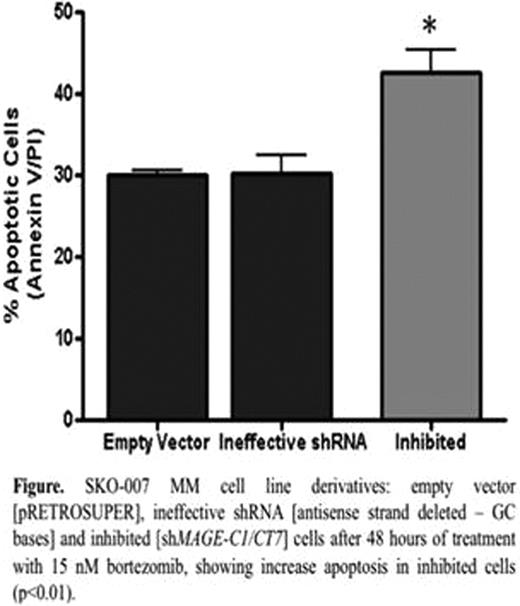Abstract
Abstract 1908
MAGE-C1/CT7 encodes for a cancer/testis antigen (CTA) frequently expressed in multiple myeloma (MM) that may be a potential target for immunotherapy in this still incurable disease. The expression of this CTA is restricted to malignant plasma cells and a positive correlation between MAGEC1/CT7 expression and advanced stage has been demonstrated for MM. It has been suggested that MAGE-C1/CT7 might play a pathogenic role in MM; however, the exact function of this protein in the pathophysiology of MM is not yet understood.
(1) To clarify the role of MAGE-C1/CT7 in the control of cellular proliferation and cell cycle regulation in myeloma cell line SKO-007 and (2) to evaluate the impact of silencing MAGE-C1/CT7 on cells treated with bortezomib.
Short hairpin RNA (shRNA) specific for MAGE-C1/CT7 was inserted in the pRETROSUPER(pRS) retroviral vector. The pRS-shRNA-MAGE-C1/CT7 was co-transfected with pCL-amphotropic packing vector in 293T cells to produce virus particles. Sko-007 myeloma cell line was transduced for stable expression of shRNA-MAGE-C1/CT7. Downregulation of MAGE-C1/CT7 was confirmed by real time PCR (RQ-PCR) and western blot. Functional studies included cell proliferation, cell cycle analysis using propidium iodide, and analysis of apoptosis using annexin V staining.
SKO-007 MM cell line was transduced for stable expression of shRNA-MAGE-C1/CT7. SKO-007 cells were divided into three derivatives: empty vector (pRS) and ineffective shRNA (antisense strand deleted – GC bases) [both used as controls for all the experiments] and inhibited (shMAGE-C1/CT7). MAGE-C1/CT7 mRNA expression was ∼5 times lower in inhibited cell line than control cells by RQ-PCR. Western blot showed 70–80% decrease in MAGE-C1/CT7 protein expression in inhibited cells when compared with controls. Functional assays did not indicate a difference in cell proliferation and DNA synthesis when inhibited cells were compared with controls. We used empty vector, ineffective shRNA and inhibited cells to determine whether inhibition of MAGE-C1/CT7 was associated with cell cycle dysregulation. We detected differences between inhibited cells and both controls regarding the proportion of myeloma cells in the G2/M phase (p<0.05). When inhibited cells and controls were treated with 10 nM bortezomib for 48h, inhibited cells showed a 48% reduction of cells in the G2/M phase but control cells have 11% (empty vector) and 10% (ineffective shRNA) of reduction (p<0.05). Inhibited cells treated with 15 nM bortezomib showed an increased percentage of apoptotic cells in comparison with bortezomib treated controls (p<0.01) [Figure].
MAGE-C1/CT7 antigen inhibition did not change cell proliferation and DNA synthesis in SKO-007 cells. However, we found that MAGE-C1/CT7 plays in cell cycle regulation, protecting SKO-007 cells against bortezomib-induced apoptosis. Therefore, MAGE-C1/CT7 silencing by shRNA could be a strategy for future therapies in MM, i.e. in combination with proteasome inhibitors. [Supported by CNPq and LICR]
No relevant conflicts of interest to declare.
Author notes
Asterisk with author names denotes non-ASH members.


This feature is available to Subscribers Only
Sign In or Create an Account Close Modal